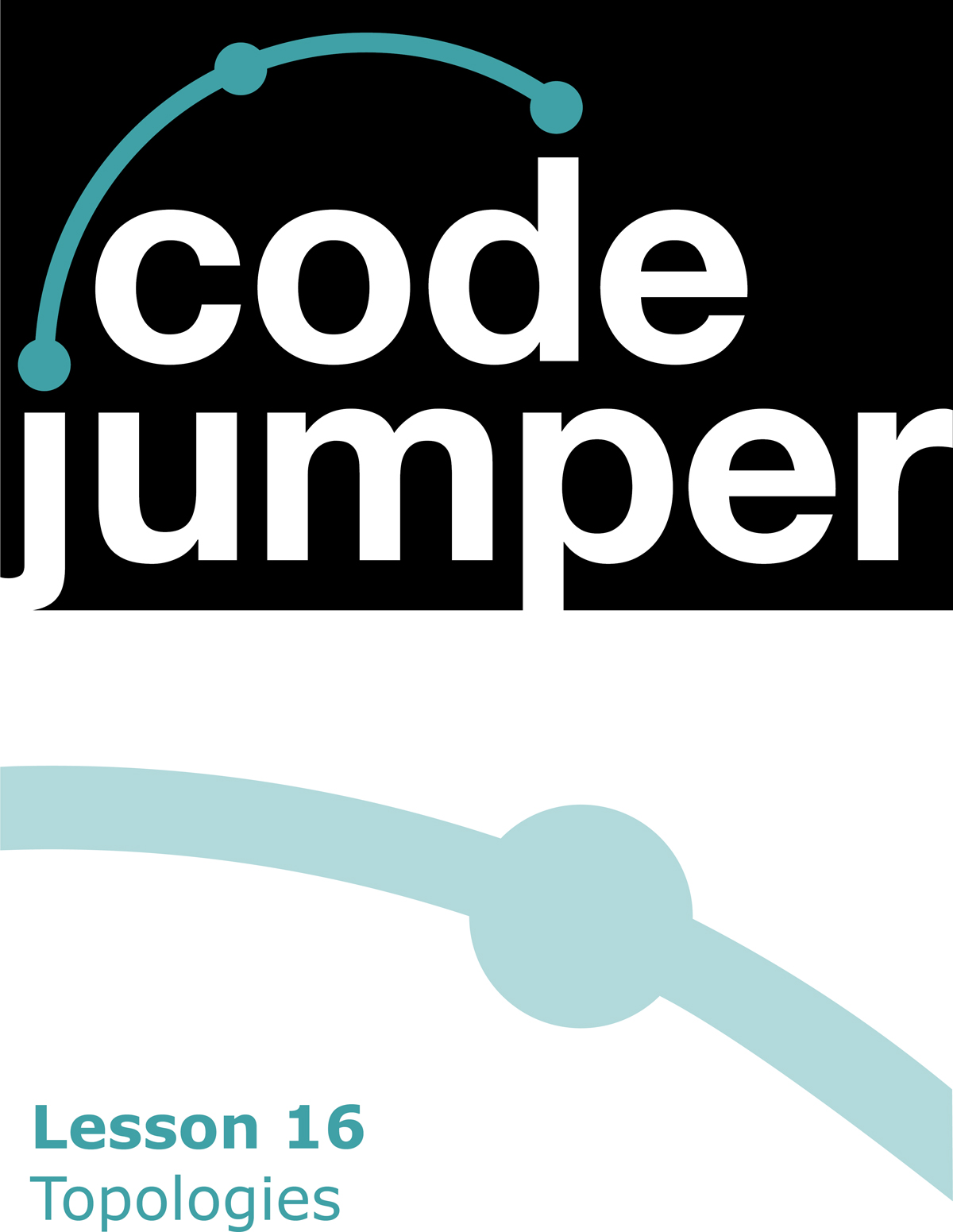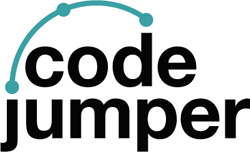
Code Jumper Curriculum: Lessons, Lesson 16 Topologies
American Printing House for the Blind
Code Jumper Curriculum: Lessons
Copyright © 2020 American Printing House for the Blind
All rights reserved. No part of this publication may be reproduced, stored in retrieval system, or transmitted in any form or by any means, except as expressly permitted under copyright law, without written permission of the publisher.
Published by American Printing House for the Blind
1839 Frankfort Avenue, Louisville, KY 40206
www.aph.org | [email protected]
Overview
Lesson Objectives
After this lesson, students will understand the benefits and drawbacks of different topologies.
Expected Outcomes
Students will:
- All students: Be able to state that a topology is a way of laying out a network
- Most students: Be able to name the three main topologies and explain how they are laid out
- Some students: Be able to explain the advantages and disadvantages of each topology
Lesson Plan Structure
- Lesson Objectives
- Introductory Lesson Activity
- Lesson Extension Activity
- Standards and Check for Understanding
Key Vocabulary
- Topology: How a network is organized, laid out, and connected
- Ring network: A network topology where devices are connected in a circle
- Bus network: A network topology where devices are connected in a line
- Star network: A network where devices are all connected to a central device.
Lesson Activity
Objective
After this lesson, students will understand what a topology is and will know the three different types of networks.
Overview
In this lesson, students will participate in an activity to simulate the bus, ring, and star topologies that can exist in different networks.
Materials
Bus Network
- Long piece of string
- Paper clips
- One set of Topology Cards (includes 16 cards total)
- Teacher Resource: Bus Topology
Ring Network
- Long piece of string
- Paper clips
- 1 set of Topology Cards (includes 16 cards total)
- Teacher Resource: Ring Topology
Star Network
- Three pieces of equal length string
- Paper clips
- One set of Topology Cards (#1-3) (includes 16 cards total)
- Teacher Resource: Star Topology
Instruction
- Explain to students that they recently learned about networks and now they will have the opportunity to understand three different types of networks, called topologies. Share that a topology is how a network is organized, laid out, and connected.
- Divide the class into groups of four and assign each group a type of topology: Bus network, ring network, or star network.
- Provide each group with the needed supplies, based on their type of network.
Bus Network:
- Tell the group of students to stand in a line and to hold a long piece of string (representing a wire in a computer network) between them. Explain that they represent computers in a bus network, along one long line known as a bus.
- Assign each student in each group a number from 1 to 4 and explain that this is the student’s address.
- Give each group several Topology Cards labeled with address numbers 1, 2, 3, or 4, representing data packets. Ask students to put paperclips on them and then hang them in random order on the string somewhere in the middle of their network.
- Ask students to transfer the packets along the network by slipping the paper clips along the string from one person to another in their network. Packets can travel in either direction along the string. Students will check the address on each packet they receive. If it matches their address, they should remove the packet from the string and keep it until the end of the activity. The paperclip should stay on the string. Tell students that if a packet reaches the end of the string, it can turn around and go in the opposite direction.
- Before students start the activity, ask them what they think will happen if two packets collide. Explain that the packets will be removed from the network and will have to be resent from the start of the network. Ask the students to remove packets from the string and set them aside if they collide.
- When Topology Cards have been received by the student with the correct address, students will resend the packets that had collided and been set aside, and the bus network will continue until all of the packets have reached their destination.
- Ask students what they think will happen if one of the connections breaks. To illustrate this, the teacher should use scissors to cut the string between two students. This will cause the whole network will go down. Students will notice that the piece of string and paperclips drop to the floor. No data packets can be sent when this happens.
Ring Network:
- Instruct this group of students to stand in a circle holding a long piece of string between them. Explain that they are computers in a ring network, where computers or devices are connected by a circle.
- Give each group several Topology Cards (representing the data packets) labeled with address numbers 1, 2, 3, or 4. Ask them to put paperclips on them and then hang them in random order on the string.
- Ask students to transfer the packets around the network. Explain that in a ring network, packets can travel in only one direction (either to the right or to the left), which prevents packet collisions. Students should check the address on each packet they receive. If it matches their number, they should remove the Topology Card from the string for the remainder of the activity. That packet stops with them.
- Ask students what they think will happen if one of the connections breaks. Have one student drop the string. Students should notice that the rest of the rest of the network appears normal, but actually cannot function because everything will stop at the dropped location. This causes the whole network to go down.
Star Network:
- Instruct this group of students to select one student to stand in the middle and instruct the other three to stand in a circle around the center.
- Assign each of the outside students an address: 1, 2, or 3. Have each student on the outside hold a piece of string that goes to the student in the middle. Do not tell students they are forming a star network yet. Explain that the student in the middle represents a switch, a device that allows computers to communicate. The students on the outside represent computers.
- Randomly give each of the students on the outside a variety of Topology Cards to feed onto their network by attaching the card to a paper clip and hanging them in random order on their piece of string.
- Instruct each student on the outside of the circle to transfer a data packet to the switch, and then instruct the switch to check the destinations on the packets and ask, for example, “Where is Computer 1?”
- When the correct “computer” replies, instruct the student representing the switch to transfer that packet to them. Continue the process until all the Topology Card have been transferred to the correct computer. As the students representing the computers receive a data packet, they will remove it from the paper clip.
- Ask the students what they think will happen if one of the connections breaks. Explain that the connection to one computer will go down, but the rest of the network will keep working. To illustrate this, ask one of the students in each group to drop their string and allow all the paper clips to drop to the floor. Make it clear that packets can still be transferred to the other computers in the network.
Closure
- Ask students from each group to share with the class the type of network they represented and how that type of topology worked.
- Ask students to discuss what went worked well and didn’t work well in their network.
- After each group has shared, discuss the advantages and disadvantages of each network type.
- Which topology is most reliable and why? (Expected response: Star, because if one connection breaks, the rest of the network will continue to work.)
- Which topology is cheapest and easiest to install and why? (Expected response: Bus, because it uses the least amount of wire to connect the computers.)”
Standards and Check for Understanding
CSTA K-12 Computer Science Standards*:
- 1B-NI-04: Model how information is broken down into smaller pieces, transmitted as packets through multiple devices over networks and the Internet, and reassembled at the destination.
National Curriculum of England**:
Key Stage 1:
- Understand what algorithms are; how they are implemented as programs on digital devices; and that programs execute by following precise and unambiguous instructions
- Create and debug simple programs
- Use logical reasoning to predict the behavior of simple programs
- Use technology purposefully to create, organize, store, manipulate and retrieve digital content
- Recognize common uses of information technology beyond school
- Use technology safely and respectfully, keeping personal information private; identify where to go for help and support when they have concerns about content or contact on the internet or other online technologies
Key Stage 2:
- Design, write and debug programs that accomplish specific goals, including controlling or simulating physical systems; solve problems by decomposing them into smaller parts
- Use sequence, selection, and repetition in programs; work with variables and various forms of input and output
- Use logical reasoning to explain how some simple algorithms work and to detect and correct errors in algorithms and programs
- Use search technologies effectively, appreciate how results are selected and ranked, and be discerning in evaluating digital content
- Use technology safely, respectfully and responsibly; recognize acceptable/unacceptable behavior; identify a range of ways to report concerns about content and contact.
Closing Activities and Check for Understanding
| Check for Understanding | Completed |
|---|---|
| Students can explain that a topology is a way of laying out a network. | Yes / No |
Topology Cards
| 1 | 2 |
| 3 | 4 |
| 1 | 2 |
| 3 | 4 |
| 1 | 2 |
| 3 | 4 |
| 1 | 2 |
| 3 | 4 |

For more resources, visit codejumper.com
Copyright © 2020

1839 Frankfort Avenue
Louisville, Kentucky 40206
502-895-2405 • 800-223-1839